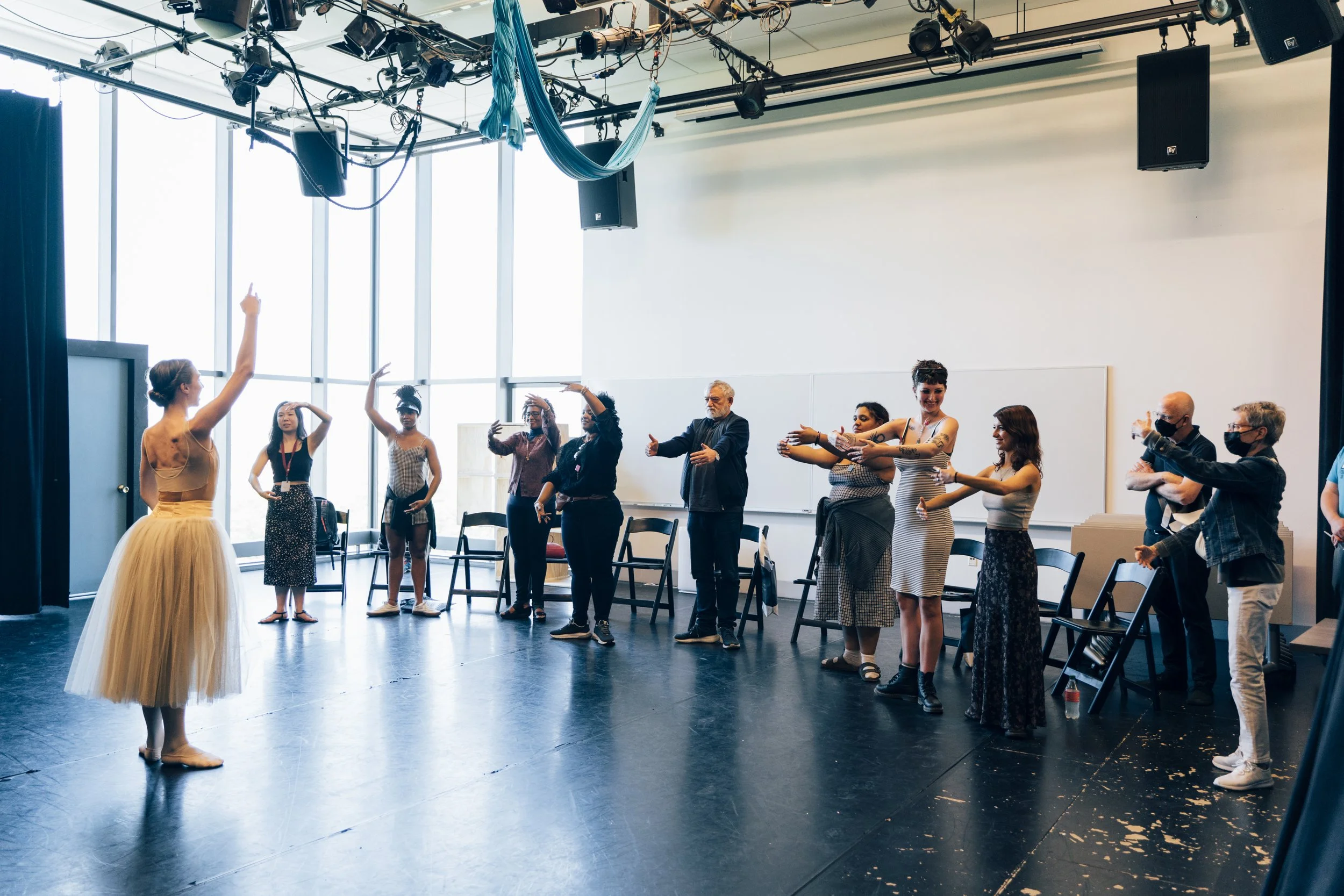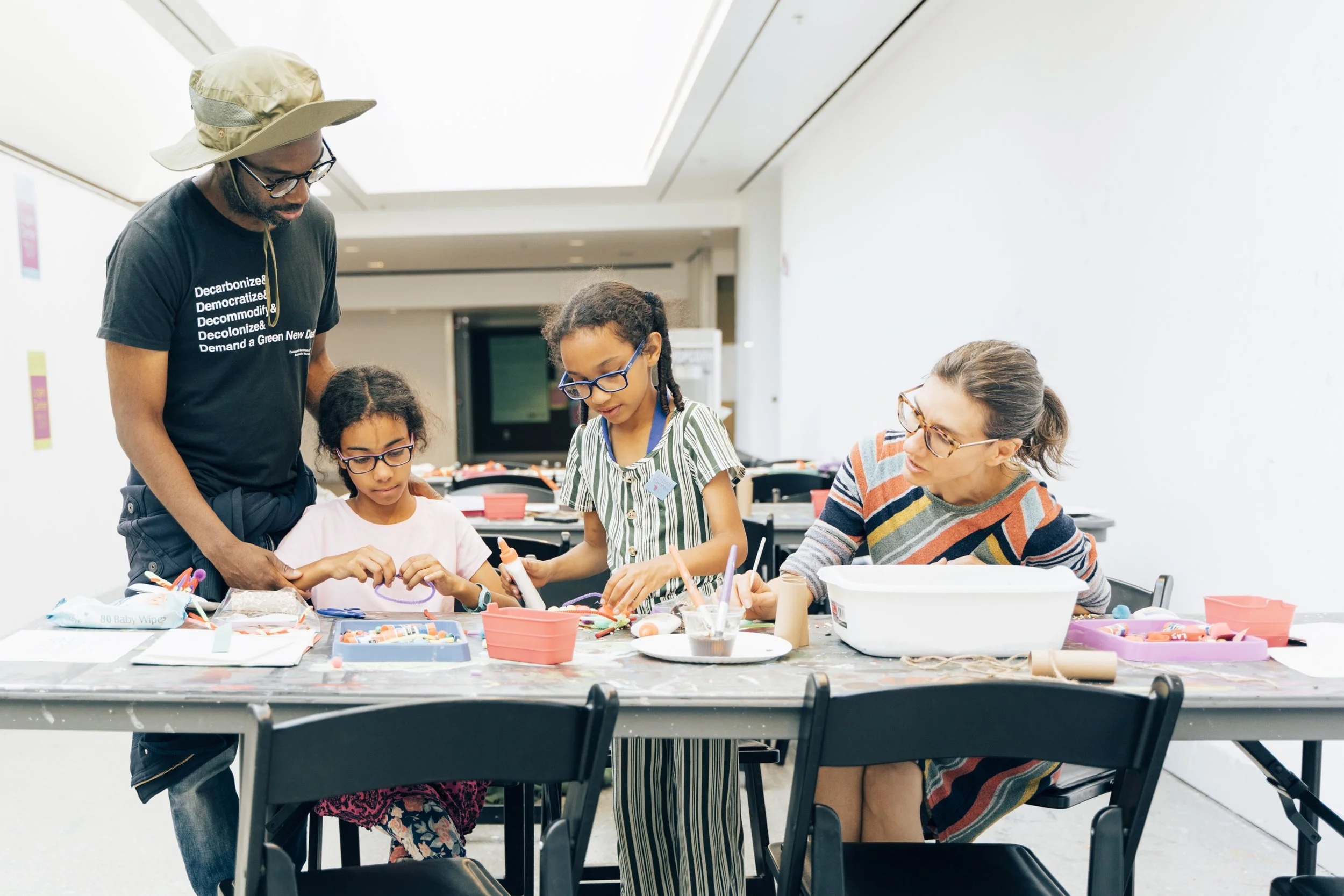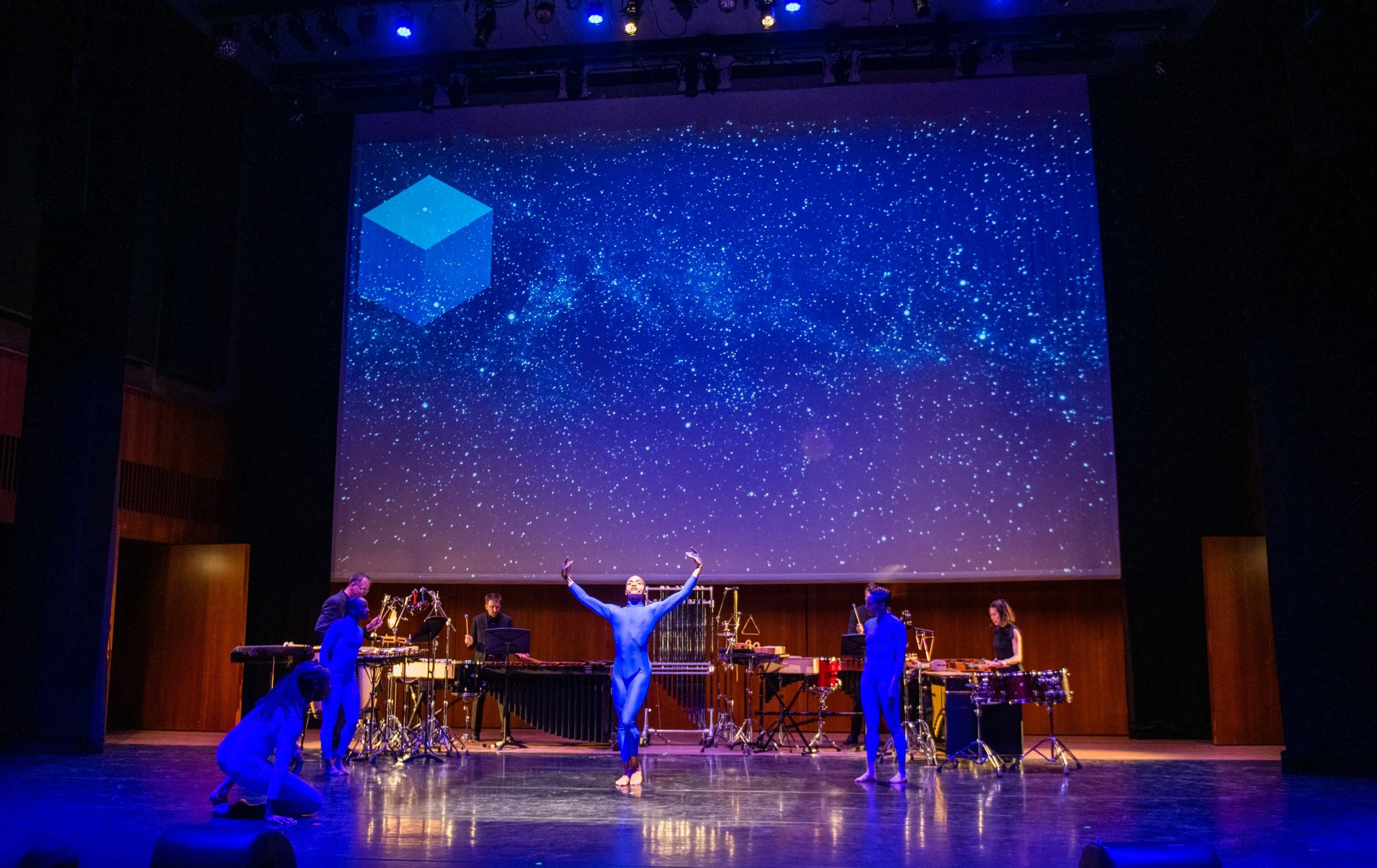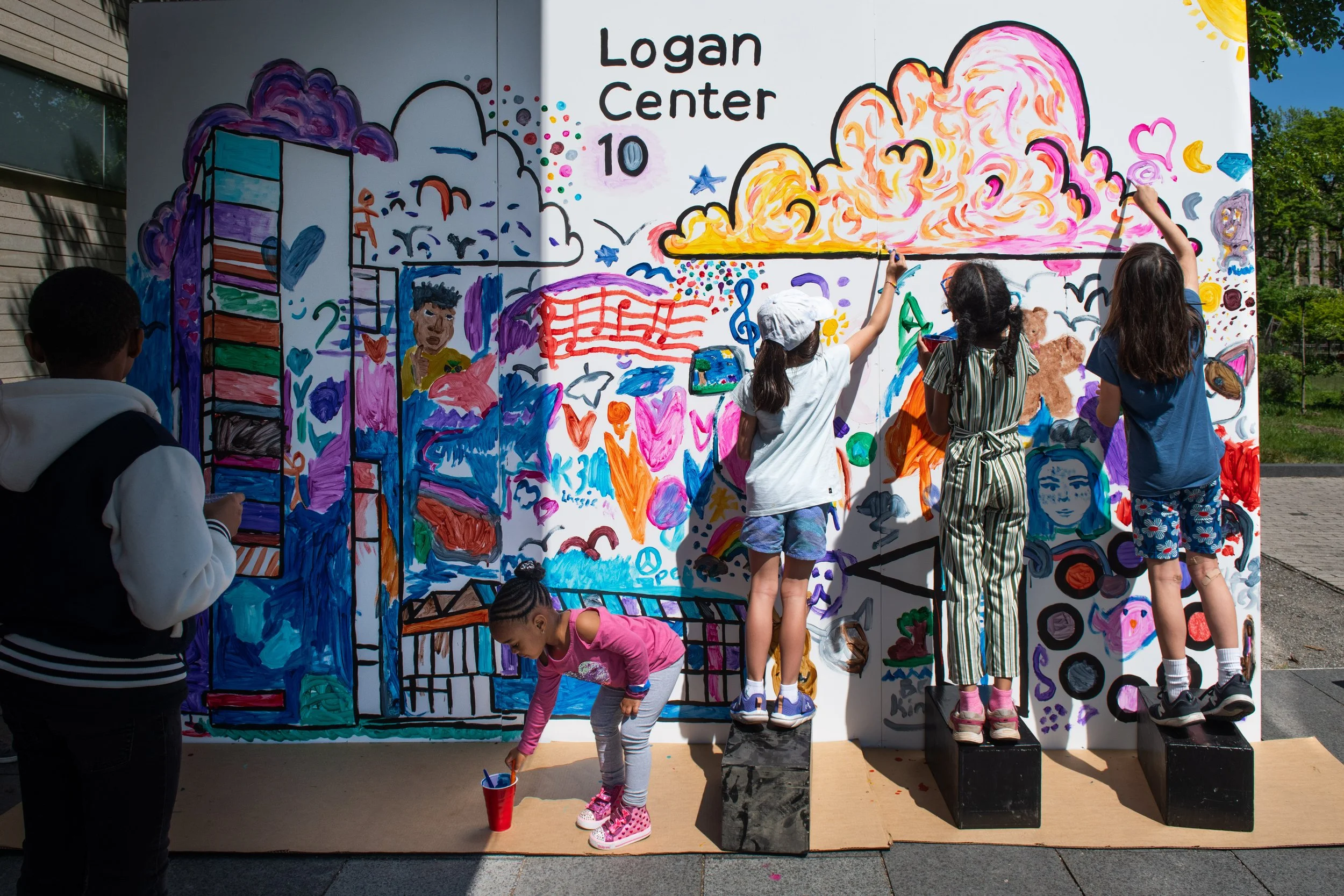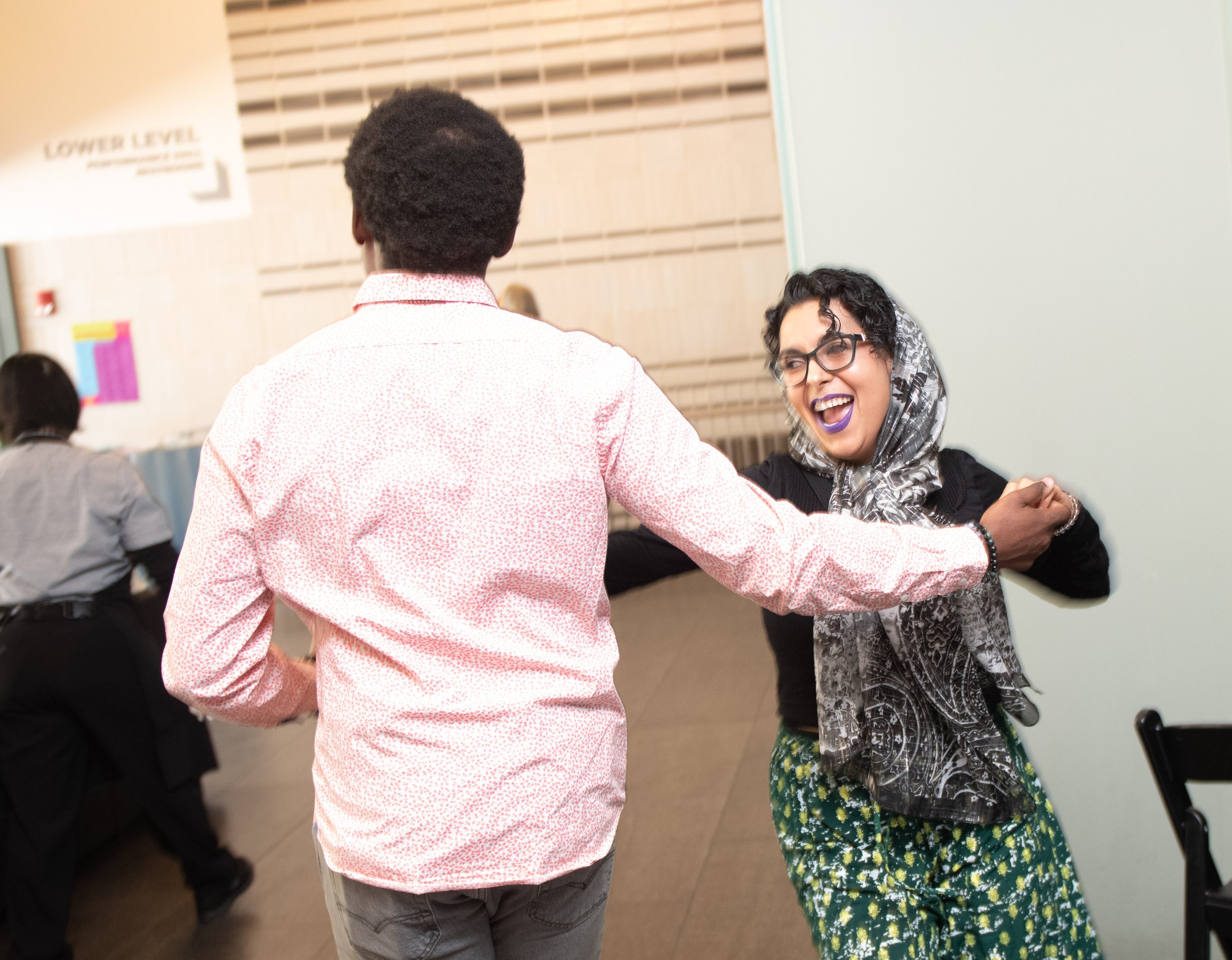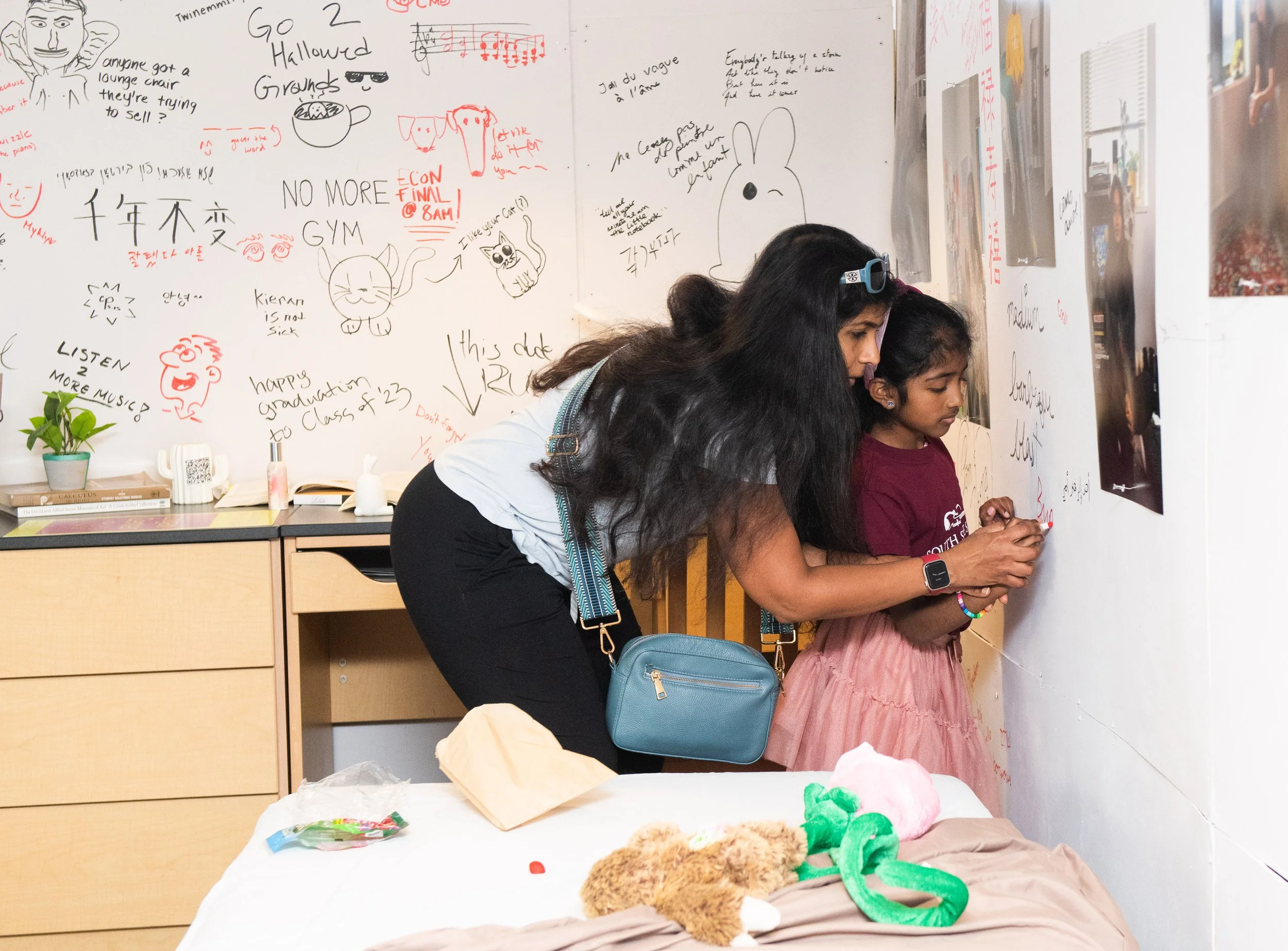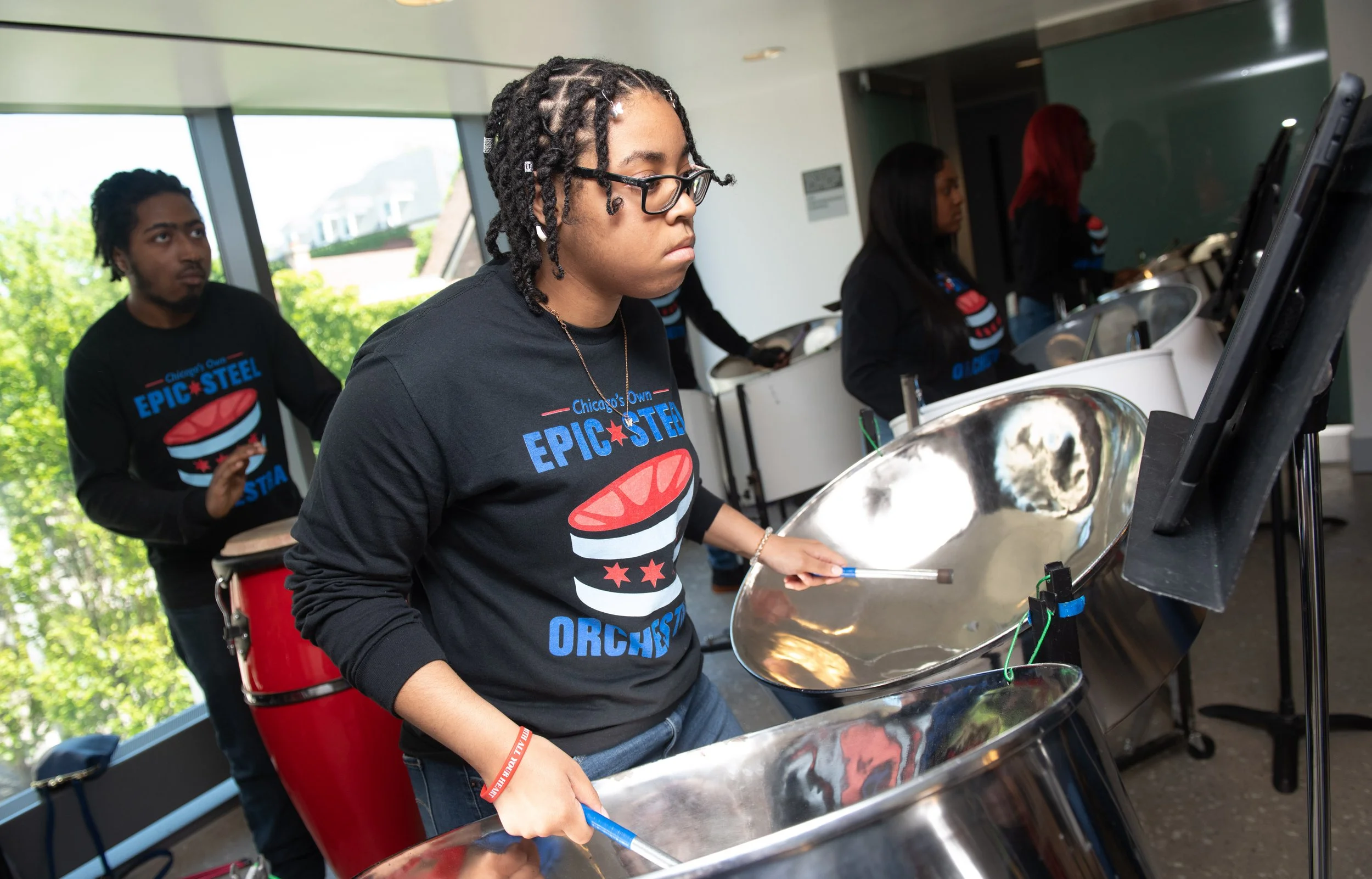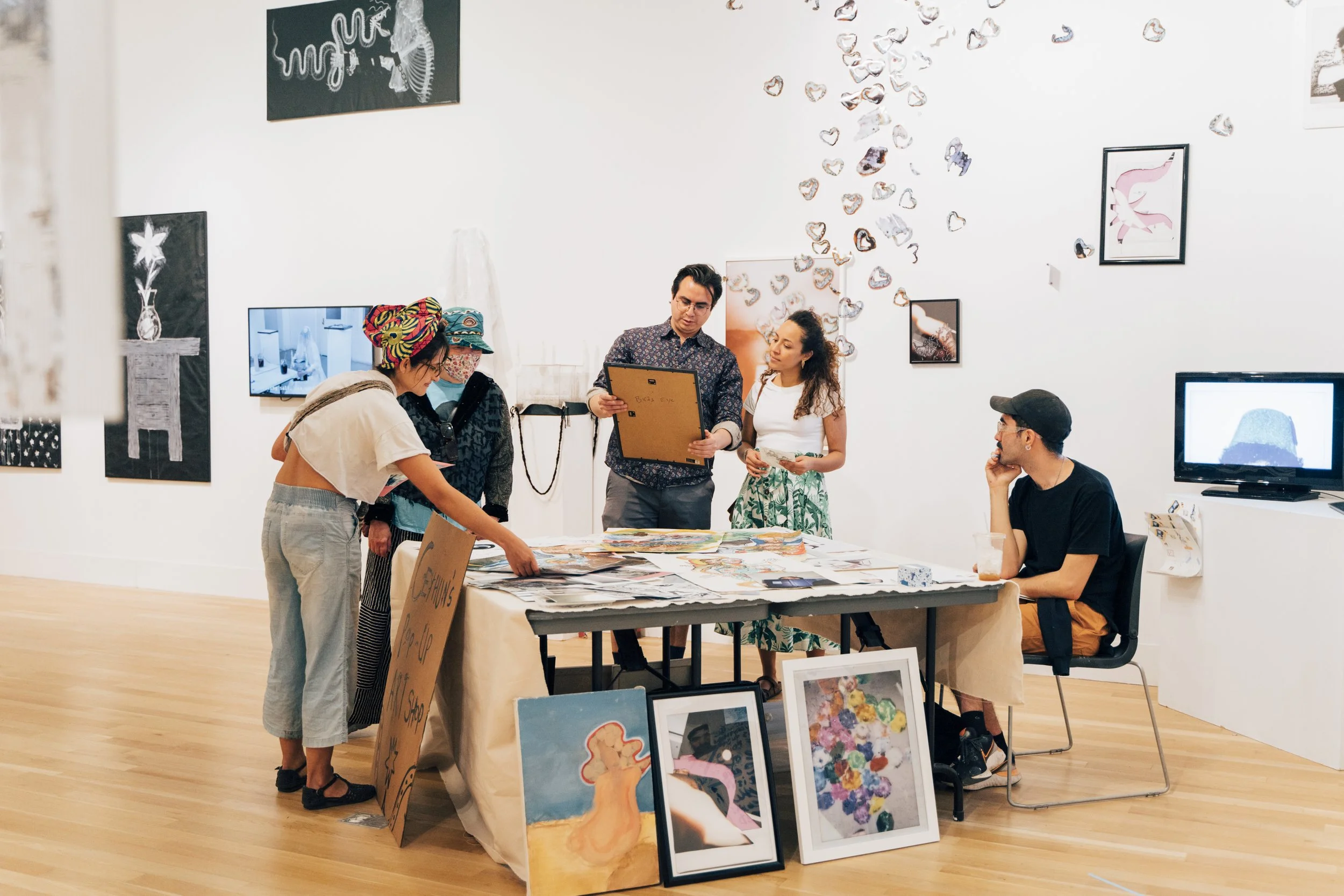Ten Years of Collaboration, Community, and Creativity
Celebrating the Logan Center for the Arts
Emily Hooper Lansana, Senior Director of Programming & Engagement, performs a poem by IL Poet Laurette Angela Jackson during the Birthday Bash | photo by Jean Lechat
by Ellen Wiese
The Reva and David Logan Center for the Arts is a living building. On any given day, the halls are full of every permutation of artistic practice—a double bass preparing for a concert on the Lower Level; community members flocking through the doors for a panel in the Performance Hall; a jazz concert in Café Logan; student circus performers perfecting acrobatics in Performance Lab 701; an open mic in the Performance Penthouse; countless classes and meetings and practices and rehearsals happening on all levels, in all spaces. It is a bustling cornerstone of the arts, not only for the University of Chicago, but in its local South Side community and across the city as a whole.
This year, the Logan Center officially marked its tenth birthday. In its first decade, it has been home to more artistic events, programs, and organizations than could fit in a single article, and has grown into something much bigger than the sum of its parts. The recent ten-year celebration not only provides an opportunity for artists, staff, and patrons to look back at all they have accomplished, but a chance to look forward to the hopes of the next decade.
Revisit the Logan Center’s 2010 Groundbreaking Ceremony
Building an Arts Center
In May 2010, more than 400 individuals gathered to witness the ceremonial groundbreaking of the site that would become the Logan Center. Situated next to Midway Studios, the space at the corner of East 60th Street and South Drexel Avenue was little more than an empty lot, but over the next nearly three years, it would grow slowly but surely to become an iconic fixture of the Hyde Park and Woodlawn skyline. In October of 2012, the brand new building was officially launched in a three-day festival that filled every level of the building with dance, music, cabaret, conversations, and more.
In the decades preceding these celebratory occasions, artistic life at UChicago had grown and thrived—through classes, professional organizations, and perhaps most importantly through student-driven artmaking. By the beginning of the 21st century, over 75 Recognized Student Organizations (RSOs) engaged more than 2,000 students in activities from theater to film to a cappella to exhibitions. These groups won awards, enriched campus life, and built community, but without the uniting presence of a space dedicated to the arts.
Participants learn some ballet fundamentals during a workshop led by Logan Community Cultural Arts Partner Ballet 5:8 as part of the Logan 10th Anniversary Birthday Bash | photo by Jeff Yin
As this artistic life expanded, it became increasingly clear that more was needed—more resources, more space, and more centralized support for the arts. In 2001, a report on the future of the arts at the University called for additional investment in the arts and a new multidisciplinary arts center. As a result, the existing arts scene at the University was joined by a number of new programs and initiatives, including the Arts, Science + Culture Initiative (ASCI), the Gray Center for Arts & Inquiry, and Arts + Public Life. As the new offerings cemented the growing role of the arts within the University, it became increasingly clear that a new home was necessary.
That new home was ultimately made possible by an unprecedented $35 million gift from alumnus David Logan, his wife Reva Logan, and their family in 2007—at the time the single largest cash gift to the arts in Chicago history.
“I remember working for the Chicago Department of Cultural Affairs and learning about the gift from the Logans to make the Logan Center possible and thinking, ‘I need to be a part of this,’” says Leigh Fagin, the Logan Center’s first-ever Senior Director of Programming and Engagement. Fagin was hired by Executive Director of the Logan Center Bill Michel shortly after the 2010 groundbreaking to help put the systems, policies, and procedures in place that would bring together these stakeholders to ultimately build this new home for the arts. “It’s so rare to see a true multidisciplinary arts space being built with so many stakeholders in mind from the beginning,” she says. “We began to imagine what was possible when all these departments, artists, and art forms would begin to share space. From the beginning, we wanted to model how a multidisciplinary art space at a university could work and what it could make possible.”
A string quartet from Hyde Park Youth Symphony, Logan Center Community Cultural Arts Partner, interactive art installation, and guests during the Birthday Bash | photo by Jean Lachat
The First Years of the Logan Center
As soon as its doors opened—and even before the official inauguration marked by the festival launch—the Logan Center was organizing and facilitating a wide variety of programming. In its first two years, the Logan Center presented student-driven performance and faculty-led exhibitions; the first Third Tuesday Jazz, a series that would become a staple of the local jazz scene; and the first major academic conference organized by the Gray Center, Comics: Philosophy & Practice, which featured award-winning cartoonists from Art Spiegelman to Alison Bechdel—in addition to a full roster of classes, rehearsals, and student events.
From the beginning, the Logan Center had ambitious artistic and programming goals, even as it became clear that more hands were needed. “The Logan staff was a lot smaller than it is now,” says David Wolf, Senior Director of Arts Technologies at University of Chicago. “It’s funny to look back from where we are today—the depth and breadth of what we do—and to contemplate doing everything with a much smaller team. At the outset, we were all putting in 110% every day to make sure that the building was a success, and we still are, but thankfully with a bit more balance.”
One of the people brought on board in those early years was Ronia Holmes, now Director of Communications for UChicago Arts and the Logan Center. Originally hired through Arts + Public Life, Holmes soon moved over to the new arts center. “It was a really solid, experimental kind of chaos,” Holmes says of the first years of the Logan Center’s development. “Most of that is chaos that involves a very expansive community.”
By the building’s five-year anniversary, the scope and ambition of the Logan Center were more evident than ever. While forging the five-year strategic plan, the staff worked with faculty, students, and community stakeholders on articulating and supporting the Center’s biggest strengths: bringing expertise and resources to the table, catalyzing content, connecting people to ideas, and supporting them at all levels. “We have had the biggest impact in cultivating relationships with the communities that surround the Logan Center and the University of Chicago more broadly,” says Wolf. “These relationships are with the broader publics who come to experience art here, and with specific arts organizations and artists who are living and working near us on the South Side. We are proud to be a part of the University where our neighbors feel a sense of belonging.”
Family art-making has been an important part of the Logan Center since its beginning | photo by Jeff Yin
It was crucial to the mission and success of the Logan Center to stay flexible and responsive; to say yes to on- and off-campus partnerships; to become both an organizing hub of the arts on campus and a place where anyone could walk through the doors and feel welcome. This meant not only saying yes to artistic collaborations from a wide variety of sources, but working hard to be inclusive and accessible. The result is a thriving, wildly disparate, completely unique node in the UChicago arts ecosystem—one that is as profound as it is impossible to summarize.
“Art is educational, it is immersive, it can be eye-opening.”
“The collection of individual stories are like chapters in a book,” says Holmes of the many individuals, groups, and programs that have made the Logan Center home over the past ten years. “Essentially, that book says that arts and culture belong to everyone. They belong to all of us as a collective species. And they should not be considered something that we only do for fun, or that’s only frivolous, or that’s only allowed to be entertaining. Art is educational, it is immersive, it can be eye-opening.”
The Logan Center’s Five Year Bash celebrated all those different meanings of art with a 12-hour festival spanning the building. Five years in, it was clear that the work those at the Logan Center had done to ensure it was a vibrant, accessible, open space had paid off. “Over time, people trusted that we were sharing interesting and important work, and work that was relevant to our community,” says Fagin. “We challenged ourselves to make all of that work accessible, and to highlight the depth and the breadth of what our communities had to offer. The Logan Center’s mission and character became about giving voice and a platform to all of those stakeholders. The question continues to be: What is the voice of the Logan Center?”
Celebrating Ten Years
On May 21, 2023, the Logan Center celebrated a full decade of operation with the 10th Anniversary Birthday Bash. Events and activities at the Logan Center often pull crowds, and this day-long festival was no exception. The wide halls of the building were full of conversation, laughter, and pop hits played on steel drums by the Epic Steel Orchestra. The sprawling, joyful party gave the sense that every group and individual that had ever been affiliated with the Logan Center had turned up to celebrate it.
Deeply Rooted Dance Theater performs Star Box by Augusta Reed Thomas | photo by Jean Lechat
At the day’s opening event, remarks from Logan Center staff were presented alongside performances from some of the city of Chicago’s brightest stars. Rather than launching the program with a speech, the event began with a performance of Nicole Starling’s We’ll All Be Free with the legendary Dee Alexander on vocals and long-time collaborator John McClean on guitar. World premieres commissioned especially for the occasion included Now I’m Listening, a new piece with music and lyrics by UChicago alumnus Will Cabaniss and Carly Wood and performed by UChicago a cappella ensemble Voices in Your Head, who also sang at the groundbreaking ceremony; a ballet performance by companies at the Hyde Park School of Dance; and the premiere of Star Box, a collaboration between Deeply Rooted Dance Theater and composer/UChicago Professor Augusta Read Thomas. “Working with the Deeply Rooted Dance Theater team, a percussion quartet playing our composition, and our whole team working in partnership with the exemplary Logan staff was without a doubt a highlight of my activities as a composer at UChicago,” Thomas said.
Chicago’s Inaugural Poet Laureate avery r. young remounted a stunning multidisciplinary piece created for Logan Center’s 2022 experimental event Remembering Ourselves Whole, and Emily Hooper Lansana, Senior Director of Programming and Engagement at the Logan Center, performed In the Center, a poem by Illinois State Poet Laureate Angela Jackson commissioned by the Logan Center in 2013.
The multiplicity of remarkable performances at the opening event alone perfectly represented the universe of art that the Logan Center has presented, created, and sustained—encompassing professional globally-recognized arts groups, student ensembles, and everything in between. And both current students and alumni of the Center’s programming were well-represented. “The Logan Center has been so important in cultivating the student arts community at UChicago,” says Caleb Olumofin, the current president of a cappella group Voices in Your Head. “It’s a place where student artists can share their work with their peers, celebrate each other’s artistic successes, and collaborate with one another.” In its decade of work at the Logan Center, Voices in Your Head has produced several singles, EPs, and albums; hosted dozens of collaborations; and recently celebrated their 25th anniversary with an alumni concert in the Performance Hall.
A large part of that musical excellence comes from the atmosphere and community the Center embodies—the live music, masterclasses, and performances hosted all year round. “These experiences have been invaluable in showing me how I can use music to express myself in beautiful and powerful ways,” says Olumofin. “I’ve been able to use what I’ve seen to generate my own musical ideas, and with the practice and recording spaces in Logan, I’m able to bring those ideas into reality.”
Since the opening of the Logan Center ten years ago, the Hyde Park School of Dance, a nonprofit dance school on the South Side, has produced a number of performances there—and they look forward to continuing to collaborate in the years to come. “Our goal is to continue providing dance instruction at the highest level of discipline and artistry. The staff at Logan are always very helpful and supportive of our programming,” say Founding Artistic Director August Tye and Executive Director LaWanda May. “The opportunity for our dancers, who range in age from five to 18 years, to dance on a professional stage has been pivotal.”
Like Olumofin, Tye, and May, every person who has come through the building has their own story of engagement. As David Levin, Stanley G. Harris, Jr. Distinguished Service Professor and until recently the Senior Advisor to the Provost for the Arts, said in his remarks, “It is impossible to summarize ten years of such riches.” The building is defined not by its architecture, iconic as it may be, but by the people and programs it holds and makes possible. In the early years, says Wolf, the pristine appearance of the building could be intimidating to artists and guests. “It took a few years for the shine to wear off and for people to feel comfortable making and displaying the sometimes messy, experimental sort of work students tend to do,” Wolf says. As Poet Laureate young said of his initial reaction to the semi-Brutalist architecture of the building, “You just gotta put some soul in it.”
Young artists help create a mural outside the Logan Center during the 10th Anniversary Birthday Bash | photo by Jean Lechat
“The biggest story we’re telling is how the arts have a direct impact on everyone’s lives, on many different levels,” says Holmes. This mission relies on the Logan Center being actively open to everyone, especially the community it serves. “What I’m really proud of, first and foremost,” Holmes says, “is that the Logan Center has proven time and time again that it does not just intend to be a good neighbor—it is a good neighbor. Our community matters a lot to us, because we are part of that community.”
photo by Jean Lechat
The day’s schedule—and the Logan Center itself—was full, with installations including the living sculpture “Untidy Objects” on the South Lawn; “Sculpting in Two Dimensions: Arabic Calligraphy” by Nihad Dukhan in the display cases on Level One; and the 2023 MFA Thesis Exhibition, “center • part” in the gallery. The events ranged from clay sculpting and wood burning to a workshop by the Chicago Black Dance Legacy Project in Theater East. Meanwhile, in the Courtyard, art making with Little Black Pearl, and performances from neXus, and Dirt Red Brass Band drew a crowd on Level One and watching from many of the overlooking windows. It would not have been possible for one person to visit all events—fitting for a Center that routinely presents so many opportunities for involvement that they defy even the best time management—and yet there was no sense of missing out on the experience. The building was alive, the stairwells full of conversation filtering from floors above and below as performances ended and began. Heeding young’s advice, the many advocates, artists, and organizers at the Logan Center put some soul in it.
This is what the Logan Center means, after ten years: people of all ages, across the Center’s many communities, coming to make and witness art in a building that is far more than its physical structure. The celebration was a testament to the power of art, and to the power of the Logan Center to include everyone in that art. “I really believe that art is the basis of what we call society,” says Holmes. “It makes everyone’s lives better. And I see that every day at the Logan Center in the artists that come through, the students, our patrons. You can actually see the difference that artistic expression has for the people who come through our building, whether they’re there to partake in art or practice art or pursue art.” The Logan Center is the undisputed heart of the arts at the University and a crucial component of the arts scene in the city and beyond—and it’s just getting started.
The Future of the Logan Center
Uncredited photo of student installation – Guests interact with Permanence, Logan Co-Creation Grant project by UChicago students Kristi Krishnan & Cristina Rodriguez | photo by Jean Lachat
“I adore this building. It’s been incredibly important to me, here at the University and in my life” said Professor Thomas at the anniversary event. “I love that this building is open, and I thank everyone that’s part of it—everyone, with a capital E—for the wonder and rapture and imagination and grace, and for the intersecting and intertwining lives of creativity and discovery.” Today, the Logan Center has more than 60 cultural and community partners. Composed of a dizzying array of constitutive parts, it truly is a universe—one built deliberately by artists, faculty, staff, students, and community members.
The ten year anniversary is an extraordinary milestone for the Logan Center and for the University of Chicago—but, perhaps more importantly, it’s also the beginning of the next era in its evolution. The Logan Center recently announced new funding for jazz and blues programming, planning is well underway for events in 2024, and artists, faculty, staff, and patrons agree that there are many more stories to tell. During his remarks at the opening event, Bill Michel recalled an experience he’s had many times over at the Logan Center over the past few years, in which patrons and artists have approached him to say, “I was here for the opening. And I’m still here.”
“The Logan Center has a big heart and big intentions and big accomplishments,” says Holmes. There are ambitious plans under consideration for the Center’s future, as the University works to provide more resources for ever-expanding campus and community programming. As the next stage in the evolution of the Logan Center begins, it requires revisiting all the questions that have shaped the Center’s evolution thus far. “We are always talking about the future and how to do what we are known for, better,” says Wolf. “For me, ‘better’ looks like slower, more sustained and deeper relationships with practicing artists that center on the production of new work, making space for more student artwork, and figuring out how to do more experimental, genre-defying projects.”
Members of the Epic Steel Orchestra perform during the 10th Anniversary Birthday Bash | photo by Jean Lechat
The Logan Center is built around partnership, inclusion, and community. “I’ve gotten to see all the work our team does come together,” says Holmes of the last few years. “We get people in the seats, we have people coming in the doors. We see people experiencing the Logan Center for the very first time, and then coming back again, and then coming back with a friend. It’s really exciting to see the fruits of all the labor that we gave behind the scenes, to maintain and build our audiences and of course to keep fighting for the position of the arts in society.
“We didn’t build the Logan Center by ourselves,” she adds. “We built it with our community. And they own the next ten years just as much as we do.”
DoVA Students and admirers of their work during the 10th Anniversary Birthday Bash | photo by Jeff Yin
“I am confident that thanks to the many who have and continue to contribute to our success – from the artists and partners we work with to our students, faculty, and staff at the University, our neighbors, audiences, and the ongoing support of our donors – including the Logan family and many others, the Logan Center will continue to be a place of possibility where our many communities come together to experience, learn about and create art long into the future.”
Add your Logan Center Story to our 10th Anniversary story gathering project. Find out more about sharing a special Logan Center memory here.



